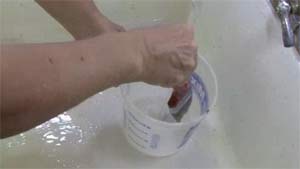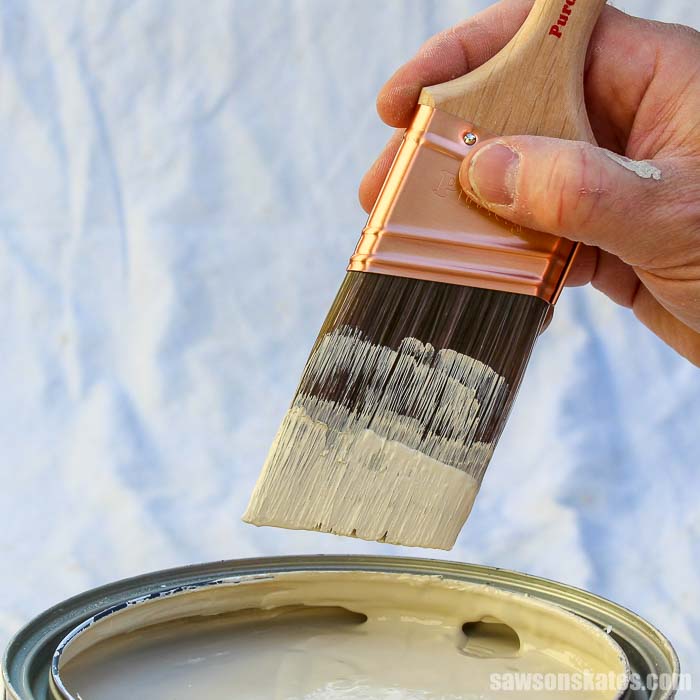A lot of times white in sinks come from the water. Like calcium lime etc. Also it is safer for a painter to wash their brushes out in a sink than outside with a hose. The paint goes down in the earth and when you wash inside it goes down a drain. Some good elbow grease with baking soda or special cleaner should do the trick. While I really dont think the amount of paint involved from cleaning brushes is going to hurt a septic system, I would rather not have such things in mine. I recommend washing the brushes outside somewhere. My septic/plumbing system is set up in such a manner that you would have to clean them in the toilet to get any paint in the tank. Wilhelm says that brushes made of natural materials, such as animal hair or fur, need to be treated more delicately, especially when washing out oil paint. 'Brushes used with oil paints require. There are special soaps that are meant for cleaning artist paint brushes. These soaps are gentle and milder on the hairs of the brush than regular hand soap, because they are specially formulated to clean and condition brushes. Usually one dish or bar of paintbrush soap will last you a very long time. Pour vinegar into your pot. If you don't want to use a pot from your kitchen, pick one up just for paint brushes at your local thrift store. Place your brush into the pot of vinegar. All of the paint covered areas of your brush should be covered with vinegar.
cleaning and storage
Clean your paintbrush thoroughly after each use
When it comes to painting with acrylics, you don't want to slack with cleaning your paintbrushes, otherwise you may wind up with a frayed and/or crusty brush that is no longer usable for traditional art-making purposes (as you will know after reading all about proper paintbrush care!). Therefore, once you are done painting, it is in your best interest to pamper your brush with a full beauty spa treatment to get it clean, refreshed, and ready for the next painting session!
How to clean paintbrushes

When you are done painting with a particular brush, you must clean it right away to avoid acrylic paint drying on the bristles. Follow this simple procedure for how to clean paintbrushes and you'll have sparkling fresh paintbrushes for the next time you want to paint!
- At your work place, before you go to the sink, place the bristles in between a paper towel or rag and squeeze out the excess paint. Note that rags are a more eco-friendly solution than paper towels because they can be reused many more times than a paper towel.
- Swish the brush around in your cup of water to release any leftover paint.
- Gently shake off the excess water and pat against towel.
- Repeat Steps 1-3 as many times as necessary to remove the bulk of the acrylic paint. This is important for Step 6.
- Go to the sink and place a small bucket, pail or bowl under the faucet. This is an eco-friendly step to prevent the acrylic paint from running down the drain and getting into the water supply.
- Rinse your brush under a small stream of running lukewarm water. Using your fingers, gently and quickly squeeze the bristles to further dislodge any leftover paint. By working quickly and using a slow trickle of water you can avoid overfilling the bucket or bowl that you've placed in the sink.
- Using special artist soap or regular hand-washing soap, put some soap on your brush and gently wash the bristles with your fingers by working the soap through the bristles.
- Rinse off the soap.
- Check to see if there is any paint left, and if there is, repeat Steps 5 and 6. Use another bucket or bowl if your first one got too full.
- Once you are certain all the paint has been removed, shake the brush to remove the excess water.
- Place the bristles in between a paper towel or rag, and squeeze out the excess water.
- Let your paintbrush dry in a safe place, preferably lying horizontally.
How To Clean Acrylic Paint Brushes
If you’re wondering what to do with the buckets/bowls of dirty acrylic paint water, check out this helpful article on the Golden website that outlines a DIY solution to remove the acrylic paint solids from your rinse water. They also offer another article on waste disposal that’s worth a read.
When I was a youngster our teachers instructed us to wash our paintbrushes in the sink, which kind of reveals my age, because nowadays there is a strong awareness about the dangers of plastics (such as acrylics) in our water supply and how even the tiniest plastic particles end up in the ocean, threatening marine life and the environment. With that in mind I try to recommend eco-friendly art practices whenever I can.
Take note that at some point or other, the hairs of your paintbrush will become tinted with some of the colors that you've been using. This is normal, and does not effect the performance of the brush. As long as the water runs clear as you're rinsing your brush, it should be clean, even if the bristles are tinted with color.



Do I need special soap to clean the paint brush?
There are special soaps that are meant for cleaning artist paint brushes. These soaps are gentle and milder on the hairs of the brush than regular hand soap, because they are specially formulated to clean and condition brushes. Usually one dish or bar of paintbrush soap will last you a very long time.
If you don't have any paintbrush soap, it's okay to use regular handsoap. Just don't use dishwashing liquid, which normally has chemicals that are too strong for the delicate hairs of an artist paint brush.
Here are some brush soaps specifically made for artist paint brushes:
I've provided links below to the relevant products so that you can easily find them on Blick Art Materials, my favorite online art supplier. I'm a member of Blick's affiliate program, which means if you make a purchase after clicking on one of these links, I'll receive a small commission (at no extra cost to you). Your purchase helps support this site, keeps it free of ads and allows me to continue making more free content for everyone to enjoy. Click here for more info.
How should I store and/or transport my paint brushes?
If you have a permanent workspace, you can simply leave your cleaned brushes lying horizontally on your tabletop or shelf until its next use. The important thing is that you don't want the bristles to get bent or damaged in any way.
I keep a lot of my brushes in a Loew Cornell Multi Bin Holder with 50 holes for holding paintbrushes, pens, pencils, etc. I have a lot of paintbrushes (72 at last count) so sometimes I double up and put 2 or 3 of the smaller ones together in one slot. The system mainly works for me as storage and organization. Because I keep so many brushes crammed into this holder, it takes a few extra seconds to look through and find the ones I need. Therefore, before I start painting I'll select the brushes I think I'll be using for that painting session and set them aside.
Paintbrush storage and transport ideas
If you have limited space and need to tuck your paintbrushes away somewhere, you can put them inside a long rectangular box, such as a shoebox or a plastic food storage container. There are also quite a few storage solutions available from the art supply stores, such as these:
If you make a purchase via the links below I receive a small commission, which helps support this site.
This Holbein Adjustable Brush Holder is the most compact of the storage ideas, making it a good option for transport. It consists of a translucent plastic tube that can hold brushes up to 13' (22cm) long. While it is handy and compact, it doesn't have a way to prevent the brushes from banging up against the end of the tube. Therefore if you use one of these, but sure not to carry it upside-down!
An alternative to the plastic tube brush holder is this neat Bamboo Brush Roll-up that can safely store and protect up to 12 paintbrushes. You can put both wet or dry paintbrushes in this bamboo cloth holder, because it is quite airy and dries easily. To transport, simply roll it up and tie it shut.
If you need to store or transport more than a dozen paint brushes, the ArtBin Essentials Brush Box is a good choice because it keeps the paintbrushes in place so that they won't bump against the end of the box and get damaged. It can hold 20 brushes, fastened in place with foam inserts. This box features vented sides, to allow the brushes to dry.
Art is Fun Paintbrush Guide
Page 1........ describes the different types of brushes for acrylics and what each paintbrush can do.
Page 2........ answers all the questions that a beginning artist will have about paintbrushes.
Washing Paint Brushes In Sink
Page 3........ explains how to safely care for your paintbrushes and keep them happy.
Page 4........ demonstrates the best way to clean, store and transport your paintbrushes.

Click here to return to the main Acrylic Table of Contents page, where you will find tons of links to all the useful acrylic painting info on this site!
